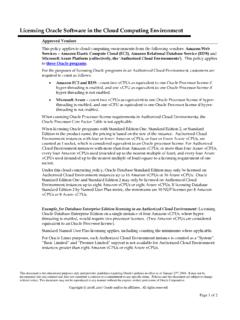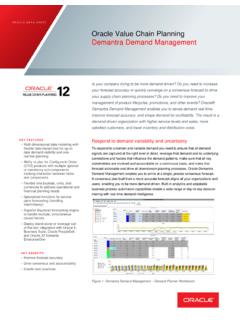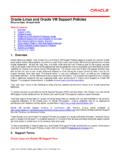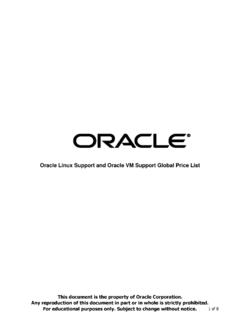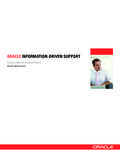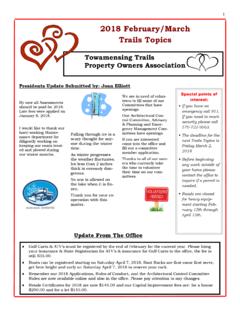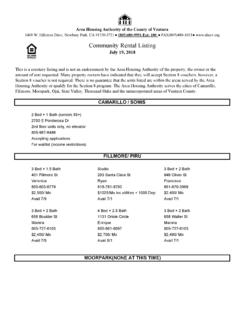Transcription of Java Client Roadmap Update - oracle.com
1 Java Client Roadmap Update An oracle White Paper march 2018 Java Client Roadmap Update Java Client Roadmap Update Disclaimer The following is intended to outline our general product direction. It is intended for information purposes only, and may not be incorporated into any contract. It is not a commitment to deliver any material, code, or functionality, and should not be relied upon in making purchasing decisions. The development, release, and timing of any features or functionality described for oracle s products remains at the sole discretion of oracle . Java Client Roadmap Update Overview .. 4 Release Cadence and Licensing .. 4 Java Deployment Roadmap .. 5 Applets .. 5 Java Web Start and Pre-Installed Java Runtime Environments.
2 5 Java UI .. 6 JavaFX .. 6 Swing and AWT .. 7 Java Client Roadmap Update 4 Overview The Java Client consists of Java Deployment (Applets and Web Start) and Java UI (Swing, AWT and JavaFX) technologies. This white paper provides an overview of the current Roadmap and recommendations for each technology. It also offers guidance for application developers, administrators, and users who rely on a stand-alone preinstalled desktop Java Runtime Environment (JRE). Executive Summary: The public availability of Java SE 8 updates from oracle has been extended to January 20191. Moreover, oracle will continue to provide consumers with updates for personal (non-corporate) use of Java SE 8 through at least the end of 2020. oracle will continue to support Java SE 8 Web Start applications for public and personal (non-corporate, non-commercial) use to the same dates noted above.
3 oracle encourages developers relying on these deployment options for the delivery of applications to consumers to migrate to other solutions. oracle will continue to commercially support Java Web Start on Java SE 8 for commercial use, or when used in conjunction with oracle products that have a Web Start dependency, through at least march 2025. As announced in 2015, Applets will continue to be supported in Java SE 8 until at least march , 2019, pending continued support by browser vendors, after which they may be removed at any time. JavaFX new fixes will continue to be supported on Java SE 8 through march 2022 and removed from Java SE 11. Swing and AWT will continue to be supported on Java SE 8 through at least march 2025, and on Java SE 11 ( LTS) through at least September 2026.
4 oracle has begun conversations with interested parties in the Java ecosystem on the stewardship of JavaFX, Swing and AWT beyond the above referenced timeframes. Release Cadence and Licensing The application development market has shifted dramatically over the past decade. On the Client side, ready-to-run mobile-first native applications and HTML5/JS web interfaces are increasingly prevalent. On the cloud side, applications are transitioning to container-based modular microservices and functions. Application developers today expect frequent updates and open-source licensing from their development platforms. 1 Dates subject to change, see for updates. Java Client Roadmap Update 5 To address these requirements, oracle proposed to shift Java to a strict time-based release model, with a new feature release every six months, and to publish OpenJDK binaries under the GPLv2 with Classpath Exception to simplify licensing and redistribution.
5 These changes create an opportunity to simplify and focus the Client Roadmap going forward. Java Deployment Roadmap Applets Java s rapid rise to fame 20 years ago began with a tumbling duke applet running in the HotJava browser, long before Microsoft Internet Explorer, Mozilla Firefox or Google Chrome were released. Applets enabled richer functionality through a browser plugin at a time when browser capabilities were very limited, and provided centralized distribution of applications without requiring users to install or Update applications locally. The Netscape Navigator browser went on to popularize a standards-based plug-in model with the Netscape Plugin API (NPAPI), which was in turn adopted by many other browsers, allowing plugins to extend the capabilities of browsers to provide cross-platform and cross-browser functionality.
6 As Java evolved to become one of the leading mainstream development platforms, so did the applet s hosts the web browsers. The rise of web usage on mobile device browsers, typically without support for plugins, increasingly led browser makers to want to restrict and remove standards-based plugin support from their products, as they tried to unify the set of features available across desktop and mobile versions. During the past five years, most browser vendors have withdrawn support for plugins such as Flash, Silverlight, and Java in their products. Supporting Java Applets in browsers was only possible as long as browser vendors were committed to supporting standards based plugins. By late 2015, many browser vendors had either removed or announced timelines for the removal of standards-based plugin support, while some introduced proprietary browser-specific extension APIs.
7 Consequently: Existing Applet support in Java SE 8 will continue through march 2019, after which it may be removed at any time. oracle announced in January 2016 that Applets would be deprecated in Java SE 9, and removed from Java SE 11 ( ). Java Web Start and Pre-Installed Java Runtime Environments Java Web Start has been included in the oracle Java Runtime Environment (JRE) since 2001. It is launched automatically when a Java application using Java Web Start technology is downloaded for the first time. Desktop shortcuts can also launch the application, providing the user with a similar experience to that of a native application. Java Client Roadmap Update 6 Java Web Start has become a migration path for developers as browser vendors continued to restrict plugin support over the past several years.
8 Since it is predominantly a desktop technology, Web Start has some limitations. In particular, it requires a standalone JRE to be installed and maintained on the user s desktop. However, over the past decade, vendors of the most popular desktop operating systems have emphatically pushed for applications on their platforms to be delivered bundled with integrated, sandboxed runtimes. Increasingly they require desktop applications to be distributed through their own private app stores. The notion of an application being distributed separately from a standalone JRE is, therefore, quickly fading. Consequently: oracle will extend support for Web Start in Java SE 8 from march , 2019, through at least march 2025. oracle products that have dependencies on Web Start will remain on Java SE 8 and continue with the support timelines as indicated by those products.
9 oracle will not include Java Web Start in Java SE 11 ( LTS) and later. oracle will begin encouraging application developers and users to transition away from Java Web Start and encourage non-commercial consumers to remove any unused or non-supported oracle JRE installations from their desktops. Developers who deploy desktop applications to individual consumers (eg, games, personal banking, or other B2C applications) will need to transition to other deployment technologies such as the jlink and/or third party packaging and deployment solutions before the end of 2020. Application developers who target applications for internal data processing, business, commercial, or production purposes, will either need to seek commercial license with oracle , or transition to other deployment technologies by January 2019.
10 Java UI JavaFX JavaFX is a set of graphics and media packages that enable developers to write rich Client applications that operate consistently across diverse platforms. Development of JavaFX started in 2005 and was officially unveiled at JavaOne 2007. oracle fully open sourced JavaFX through OpenJFX in 2011, and continues to contribute to its open-source development. Java Client Roadmap Update 7 Over the last decade, the JavaFX technology has found its niche where it enjoys the support of a passionate developer community. At the same time, the magnitude of opportunities for cross-platform toolkits such as JavaFX in the market place has been eroded by the rise of mobile first and web first applications. Consequently: oracle will continue to support JavaFX new fixes for Java SE 8 until 2022.
